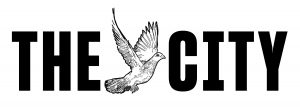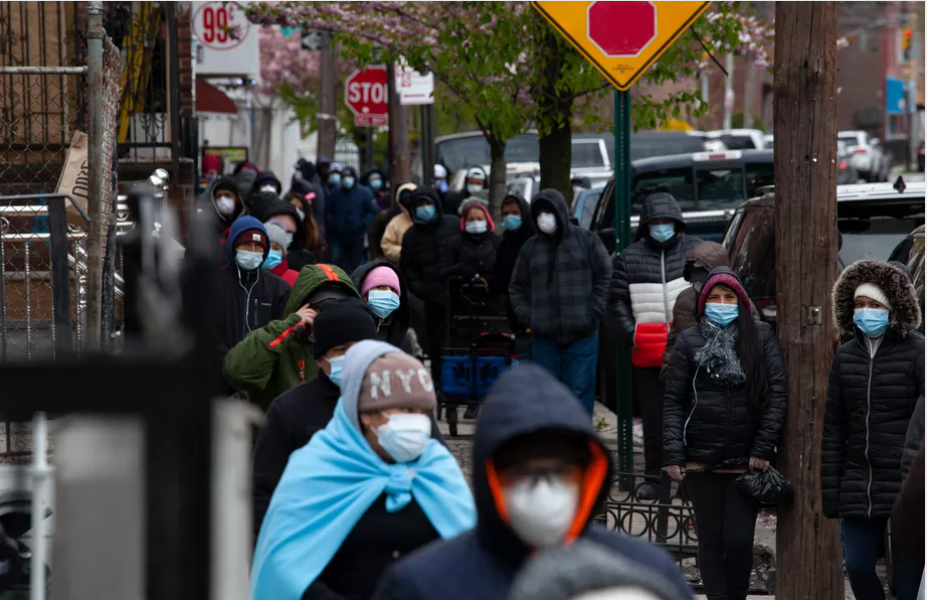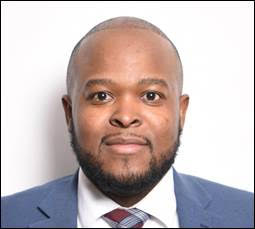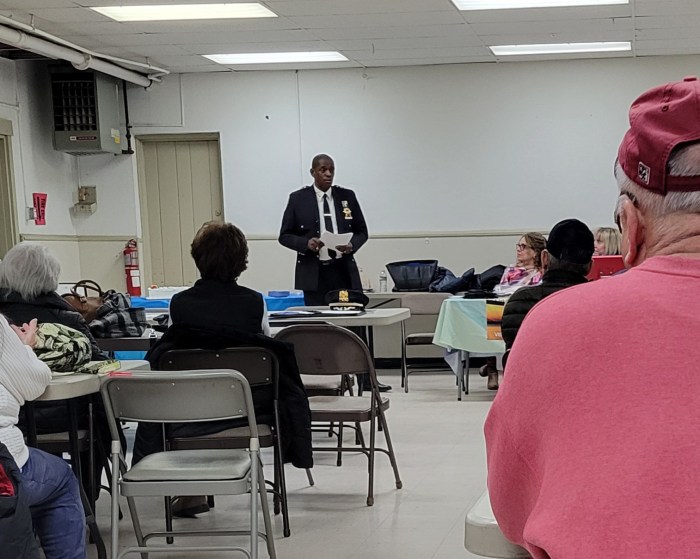By Claudia Irizarry Aponte and Christine Chung

This story was originally published on June 21, 2020 by THE CITY.
Half of New York’s working-class immigrants have lost their jobs as a result of the COVID-19 pandemic, a new study by the Center for Urban Future found.
The sudden loss of income has made it difficult for many immigrants to get relief, since they may be ineligible for most public benefits because of their citizenship status.
That means that food stamps, rent subsidies, cash assistance, unemployment insurance and stimulus checks are out of reach for most of New York’s estimated 350,000 undocumented workers and their families in the event they lose work.
Meanwhile, the pandemic has laid bare existing struggles with language and technology access for the city’s immigrants, which created barriers in access to care such as telemedicine and crisis hotlines, the study found. Those issues extend to families who have undertaken remote learning for their children, the report notes.
For undocumented immigrants, the city’s lowest earners despite high participation in the labor force, unemployment can be uniquely devastating, extending to tolls on physical and mental health, the study found.
“So many New Yorkers are struggling right now, but I’m not sure that any group has fared worse than the city’s immigrants,” said Jonathan Bowles, executive director of the Center for Urban Future. “They’re affected the most by the health and economic impact of the crisis, and yet they’ve been the least likely to benefit from the government’s programs.”
Many wonder how they will pay back the rent they owe now that a statewide eviction moratorium ended on Saturday. The Aug. 20 moratorium extension authorized by Gov. Andrew Cuomo excludes many undocumented people, THE CITY previously reported.
The extension only applies to those who can show loss of income related to the coronavirus through such as proof of unemployment insurance, which undocumented people and so-called gig economy workers are ineligible for.
That includes people like Mohamed, who asked that his full name be withheld. The 35-year-old Egyptian immigrant has been unable to operate his Midtown food cart since March 10 and has resorted to taking loans from friends to pay his rent and bills, including for cart storage.
“I need support from the city. I need a grant or a loan to pay back what I owe the garage and be able to go back to work,” he said in Arabic through an interpreter. “I have nothing at the moment.”
‘A Dismal Social Safety Net’
The Center for Urban Future surveyed 25 community-based organizations and providers serving thousands of immigrants across the five boroughs to get a sense of how many members have become unemployed because of the pandemic and how many are food insecure.
The findings paint a grim picture.
In Harlem, 90% of immigrants served by the African Services Committee have lost their primary source of income. One in four clients of Queens’ Libertas Center for Human Rights are experiencing food insecurity, meaning they worry about how to pay for their next meals.
For members of the New Sanctuary Coalition, which serves undocumented immigrants citywide, that number’s around 40%.
Many of the organizations surveyed have distributed food or financial relief for impacted clients, or connected them to food pantries, according to the report.
Among them is La Colmena, which represents immigrant day laborers in Staten Island.
“On food distribution days, about 300 or 400 people come,” reported La Colmena executive director Yesenia Mata, who said that 95% of members are without work. “In an hour, the food’s gone.”
:no_upscale()/cdn.vox-cdn.com/uploads/chorus_asset/file/19996043/485926cd92f9660eb2f6065036d615fd0fd8_jackson_heights_closed_stores.jpg)
“The theme that this pandemic has revealed is that this country has a dismal social safety net for citizens, and none for immigrants,” said Will Zentmeyer of the New Sanctuary Coalition. “And that’s a reality that’s become abundantly clear with this pandemic.”
That means workers out of a job often face impossible decisions.
Jesús Avilés had just sent a monthly allowance to relatives in his native Mexico when the Midtown restaurant where he worked closed indefinitely on March 15.
He’d already paid for the room he rented in a Queens home through the end of the month. But with only about $1,000 to his name, he had to choose between spreading out his cash for however long the lockdown lasted, or spending most of it to stay in his room for another month.
He’s been living in a homeless shelter in Brooklyn since April unsure when — or if — he’ll return to his old job.
“I come from a very poor family. I’ve done everything I could over the last 20 years to get a visa, a work permit,” Avilés said in Spanish. If he had either of those documents, he’d likely qualify for a stimulus check, unemployment insurance, food stamps, and emergency rent assistance.
“I survived 9/11, the blackout and the 2008 crash, but nothing like this,” he said. “I work hard and I save what I can, but unfortunately we don’t get any help from the government.”
Barriers to COVID Care
As THE CITY has previously reported, blue-collar immigrants — many of whom work in industries deemed essential — have borne much of the brunt of the COVID-19 pandemic.
Job losses, business closures, food insecurity, remote learning, and the trauma associated with losing family or community members to COVID-19 — or getting sick themselves — is weighing down the mental health of immigrant communities, the study found.
“Apartment overcrowding, prevalent in many immigrant communities, leads to increased risk of coronavirus transmission and can add to the mental and physical toll of sheltering in place,” according to the study. “Several organizations mentioned that immigrant clients are struggling to access testing and in some cases treatment for COVID-19.”
:no_upscale()/cdn.vox-cdn.com/uploads/chorus_asset/file/19960158/6554e634fb91b912ffc7a1a7483e9b87303a.jpg)
In March, nearing the peak of the pandemic in New York, and knowing their symptoms were not severe enough to warrant a visit to the emergency room, Gloria, a domestic cleaner, and her husband went to a private medical facility to seek treatment for COVID-19. The bill for the couple, who asked that their last names be withheld, ran them about $400.
“We haven’t received any help from the government, we’re standing up and struggling every single day,” Gloria said in Spanish. “The government does nothing for its immigrants.”
With her husband out of his job in construction — and clientele evaporating for Gloria — the couple had few options to put food on the table for their 4-year-old daughter and pay their rent. They are now getting some financial assistance through the Workers Justice Project, a local day laborer advocacy group, but acknowledge the relief only goes so far.
In its report, Center for Urban Future proposes expanding support for community-based preventive and mental health providers that serve immigrant communities — including providing resources for COVID-19 testing.
Many community members, the study notes, may be more willing to go to their trusted provider rather than visiting a hospital emergency room, or a state-run clinic, out of fear of government authorities.
The report further recommends extending support to organizations that provide interpretation services in languages beyond those served by the city, such as indigenous languages.
Emotional Health Suffers
Some providers surveyed for the study that offer mental health counseling and preventive care have transitioned to remote consultations.
Demand for mental health services has more than doubled in Sunset Park’s Academy of Mental and Public Health Services, which serves the neighborhood’s Latino and Chinese communities, according to executive director Mon Yuck Yu.
“What we’re seeing is that the struggles are multi-fold,” she said. “From a mental health perspective in particular, we’ve seen a lot of clients who have really experienced loss, and loss comes in many different ways: maybe it’s the loss of a family member, loss of a job, or simply loss of a sense of security.”
Adhikaar, a Queens-based organization that serves Nepali-speaking communities, is connecting members in severe distress with Nepali-speaking counselors in partnership with a group called the Be Well Initiative.
A month ago, the group began peer counseling support training for members, in collaboration with a clinical professional who speaks Nepali, said Prarthana Gurung, a spokesperson for Adhikaar.
That program is being piloted by Adhikaar’s members in the nail salon industry, who have been uniquely devastated by the pandemic: “All” of the nearly 2,000 members employed as nail salon workers have lost their jobs, according to the Center’s report.
Waiting for Aid
To stave off the impact of job loss for the community, the Center for Urban Future proposes creating a state or city-funded emergency cash assistance program for undocumented people left out of federally provided relief. It’s an idea that advocates for undocumented immigrants have pushed for in the state and city legislatures since the start of the pandemic.
City Comptroller Scott Stringer proposed a similar concept in April, which would use funds provided by private entities or partners.
Neither the state or the city has acted yet on either proposal.
“When you think of how important immigrants have been to the city’s economy over the last few decades it’s, you know, this is the time when they need help the most,” Bowles said. “And it feels like the city’s turning its back on them.”
Likewise, to circumvent federal restrictions, the Center also is calling for using state or city funds to provide paid sick leave, child care and additional protective equipment for the city’s immigrant essential workers, who make up one-fifth of that workforce, according to a recent analysis by the comptroller’s office.
Bowles acknowledged the fiscal challenges the city faces — with a projected $9 billion hole in its budget — to achieve these goals.
“These are difficult fiscal times but, we have hundreds of thousands of people who are falling deeper into poverty who are at risk of becoming homeless and at risk of becoming hungry,” he said. “The federal relief package totally ignored immigrants and maybe it’s not much of a surprise, but it seems like city and state leaders haven’t done enough to pick up the slack.”
This story was originally published by THE CITY, an independent, nonprofit news organization dedicated to hard-hitting reporting that serves the people of New York.




































